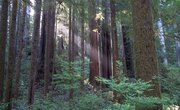
California is the most populous state in the United States and, with a total area of 158,706 square miles, it's the third largest state after Alaska and Texas. The geographical diversity within its borders, arguably unmatched by any other state, is typified by its four well-defined regions. These regions include the Coast, the Deserts, the Central Valley and the Mountains. Each has a distinct climate and topography, and each is the natural habitat for a plants and wildlife unique to that region.
TL;DR (Too Long; Didn't Read)
TL;DR: California has four main geographical regions that differ in population, economics, wildlife and climate: the Coast, the Central Valley, the Mountains and the Desert.
The Coast
The bulk of California's population – 68 percent – lives in the coastal region and accounts for 80 percent of the state's economy. People living in northern communities experience colder weather and more fog than those in southern ones, but all benefit from the moderating influence of ocean winds. The average temperature in Crescent City near the Oregon border is almost 52 degrees Fahrenheit, while in San Diego, it's close to 64 degrees.
Besides being colder, the northern coast receives more rainfall, which creates the ideal conditions for coastal redwoods. The large conifers form dense forests that occur naturally nowhere else in the world. California's coast is home to seals, sea lions and otters, and humpback and blue whales are yearly visitors to the deep submarine canyons of Monterey Bay on the Central Coast.
The Deserts
Found in the southeastern part of the state, California's three deserts, the Great Basin, Colorado and Mojave, are hot and dry. Receiving only 4 to 10 inches of rain every year, the deserts can experience temperatures in excess of 120 degrees Fahrenheit. In fact, Death Valley in the Mojave Desert, which is the lowest point in the continental United States, experiences some of the hottest temperatures on Earth.
The desert climate isn't hospitable, and few people live there. But many plants and animals thrive. Plants include the Joshua tree, the creosote plant, the Mojave yucca and the prickly pear cactus. Animals indigenous to California's deserts include diamondback rattlesnakes, sidewinders, coyotes, desert tortoises and the odd scorpion.
The Central Valley
California's Central Valley, bordered on either side by mountains and stretching more than 400 miles from Bakersfield to Redding, contains some of the world's most fertile and productive farmland. If you enjoy raisins, almonds or pistachios, there's a good chance your favorites were grown here. Taking advantage of the region's moderate climate, farmers can even grow olives.
Two rivers drain water from the low-lying Central Valley and prevent it from turning into a swamp. They are the 320-mile Sacramento River in the north and the 350-mile San Joaquin River in the south. These rivers meet at a break in the Coastal Range and empty into the northern part of San Francisco Bay.
The Mountains
If you're looking for mountains, California has them. In fact, the Sierra Nevada Range, which straddles the border with Nevada, has the tallest peak in the continental United States. Mount Whitney, with an elevation of 14,494 feet (4,418 meters), is located less than 100 miles from Death Valley, the lowest point. The Sierras extend north to the Cascades, which feature Mt. Lassen and Mt. Shasta, two extinct volcanoes that dazzle motorists on Interstate 5, which passes by the foot of Mt. Shasta.
California's two main ranges – the Sierra Nevada and the Coastal Range – contain 41 mountains with elevations in excess of 10,000 feet (3,050 meters). In addition to the Sierras and the Coastal Range, the state has several smaller ranges, including the Siskiyou Range near the Oregon border and the Tehachapi Mountains in the south.
Besides giant Sequoias, which are related to Coastal Redwoods, California's Sierra range is the natural habitat of the bristlecone pine. Some of these stubby conifers are estimated to be over 4,000 years old, making them among the world's oldest living trees.
References
- Encyclopedia.com: California
- NOAA: The National Significance of California's Ocean Economy
- U.S. Climate Data: Climate California - Sacramento
- United States Department of Agriculture: Ancient Bristlecone Pine Forest
- U.S. Climate Data: Climate San Diego - California
- U.S. Climate Data: Climate Eureka - California
- National Park Service: Seeing and Climbing Mt. Whitney
About the Author
Chris Deziel holds a Bachelor's degree in physics and a Master's degree in Humanities, He has taught science, math and English at the university level, both in his native Canada and in Japan. He began writing online in 2010, offering information in scientific, cultural and practical topics. His writing covers science, math and home improvement and design, as well as religion and the oriental healing arts.
